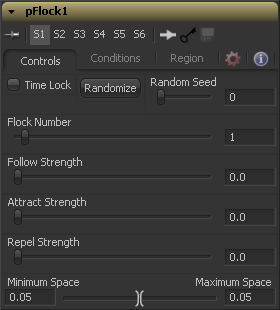Eyeon:Manual/Fusion 6/pFlock
From VFXPedia
[ Main Manual Page ]
Contents |
The following five parameters control the behavior of the Flocking system.
Controls Tab
The Seed slider and Randomize button are presented whenever a Fusion tool relies on a random result. Two tools with the same seed values will produce the same random results. Click on the Randomize button to randomly select a new seed value, or adjust the slider to manually select a new seed value.
The value of this control represents the number of other particles that the affected particle will attempt to follow. The higher the value, the more visible `clumping' will appear to be in the particle system, and the larger the groups of particles will appear to be.
This value represents the strength of each particle's desire to follow other particles. Higher values will cause the particle to appear to expend more energy and effort to follow other particles. Lower values increase the likelihood that a given particle will break away from the pack.
This value represents the strength of attraction between particles. When a particle moves farther from other particles than the Maximum Space defined in the pFlock tool, it will attempt to move closer to other particles. Higher values cause the particle to maintain its spacing energetically, resolving conflicts in spacing more rapidly.
This value represents the force applied to particles that get closer together than the distance defined by the Minimum Space control of the pFlock tool. Higher values will cause particles to move away from neighboring particles more rapidly, shooting away from the pack.
This range control represents the distance each particle attempts to maintain between it and other particles. Particles will attempt to get no closer or further than the space defined by the Minimum/Maximum values of this range control. Smaller ranges will give the appearance of more organized motion. Larger ranges will be perceived as disorganized and chaotic.
Conditions and Regions Tab
Please see 'Particle Common Controls' in the Particles chapter.
Tips for pFlock (edit)
EyeonTips:Manual/Fusion 6/pFlock
| The contents of this page are copyright by eyeon Software. |

